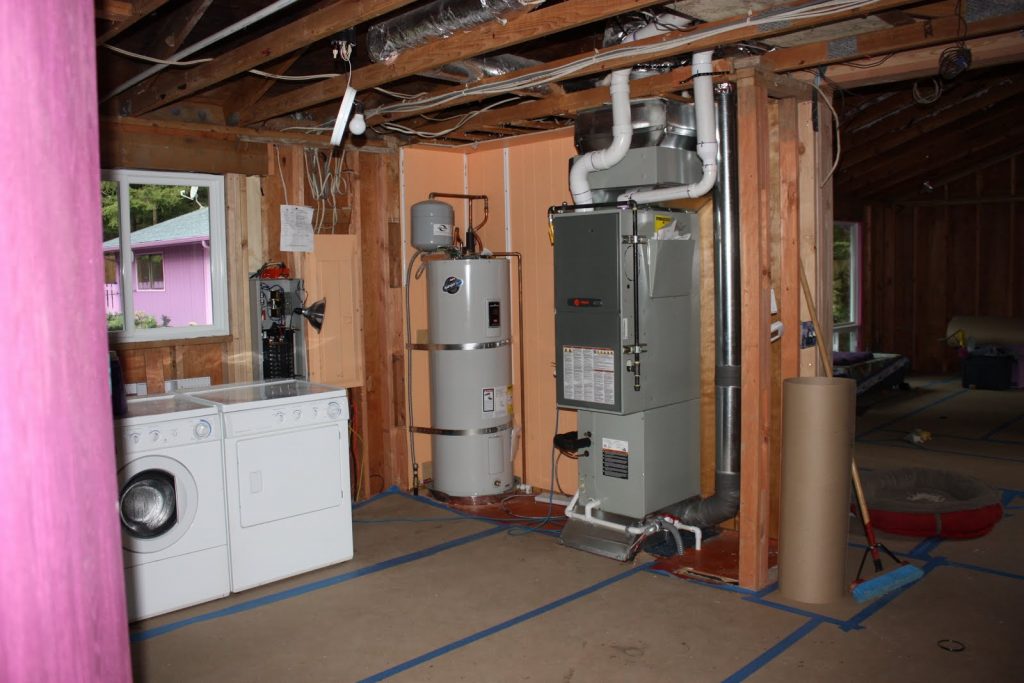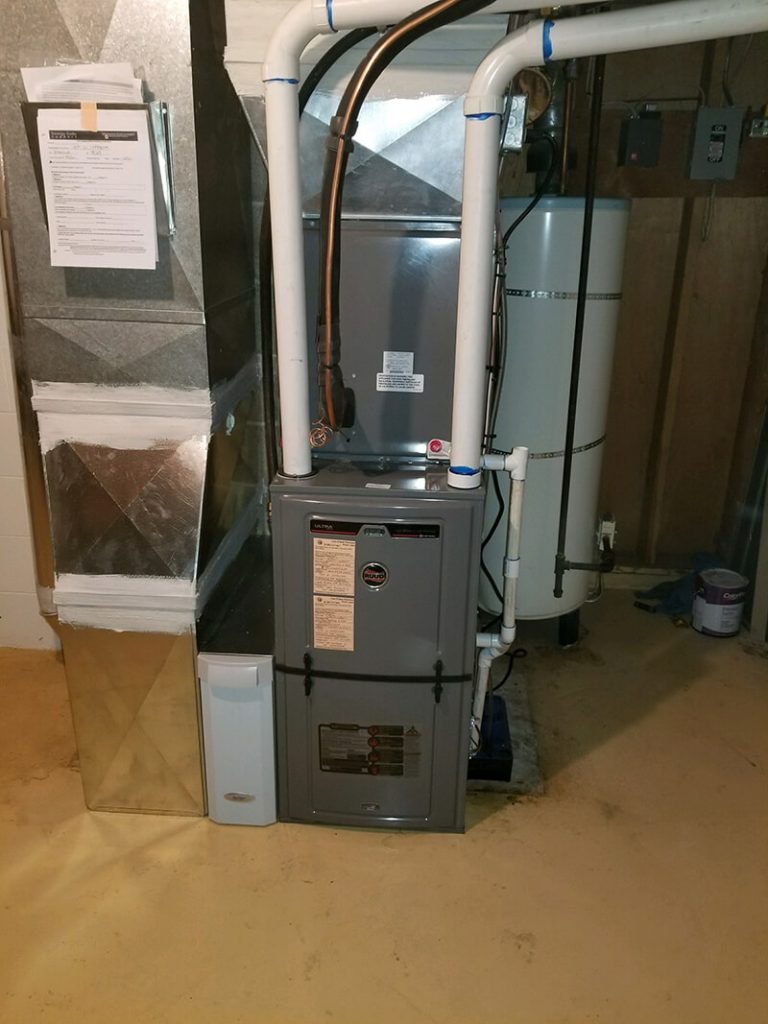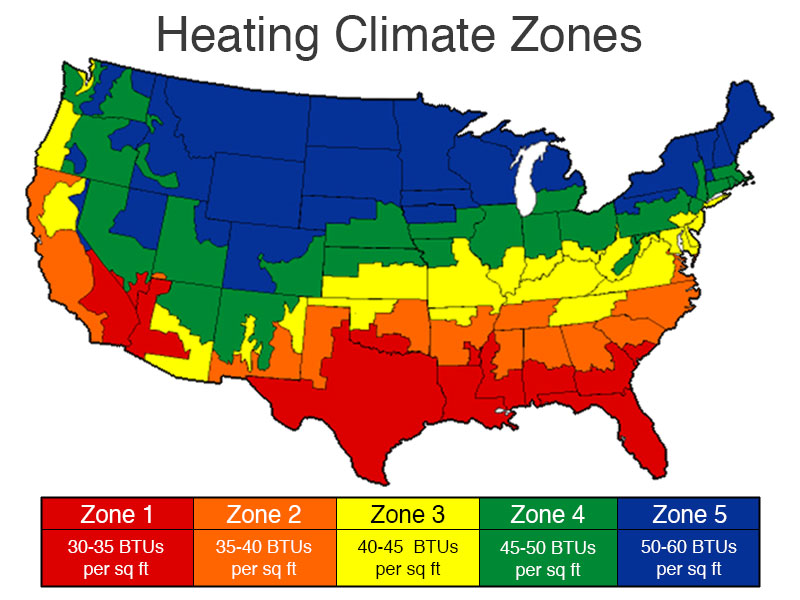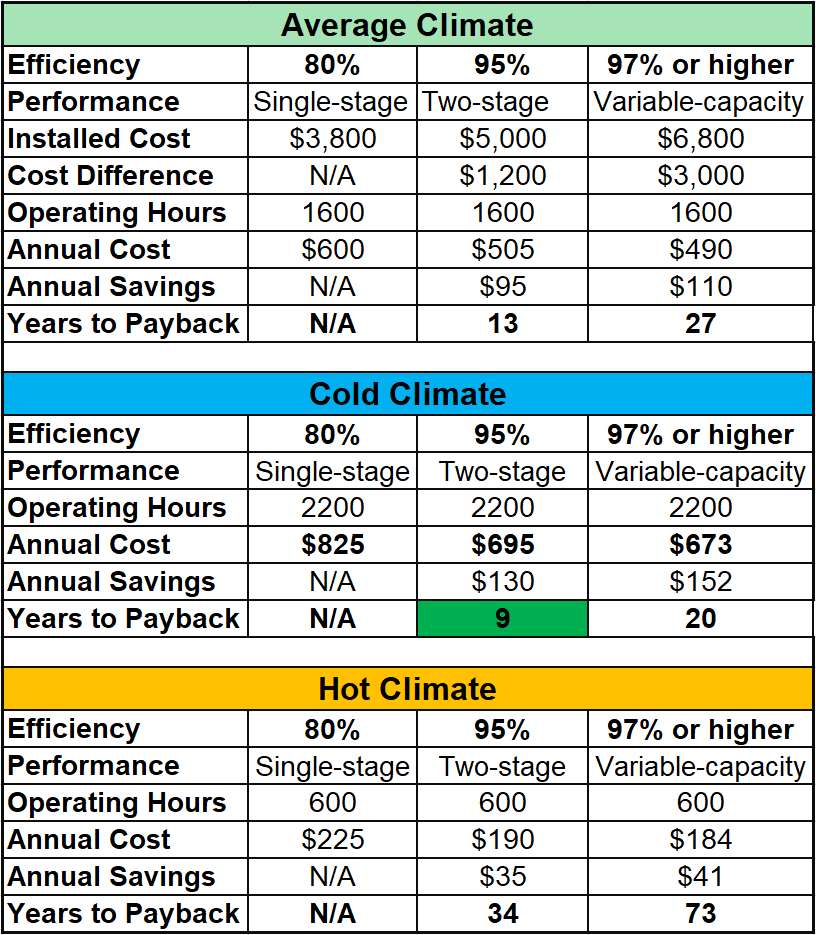Furnaces remain the most common way for homeowners in North America to heat their homes. This buying guide has all the research and information needed to help you understand your gas furnace options, so you can make a buying decision you’ll be happy with for the next 15-20 years.

The focus is on gas furnaces, since most furnaces are fueled by natural gas (NG) or, with a simple gas valve change, liquid propane (LP). However, for comparison, we also briefly discuss oil furnaces.
New Gas Furnace Installation Cost
On average, you can expect to pay between $3,500 and $5,500 to install a mid-range gas furnace in a typical house. With replacements, the removal of the old furnace will typically add an additional $500 to the cost of installation.
When efficiency, size and performance are factored into the equation, expect the following unit pricing tears:
- Basic: $750 to $1,550
- Better: $1,100 to $2,550
- Best: $1,850 to $2,950
Furnace installation costs are based on the complexity of the furnace, sheet metal work required to connect it to the existing ductwork, and how difficult it is to access the installation location such as a crawlspace or attic. Expect estimates for the installation work in these ranges:
- Basic installation: $1,500 to $2,500
- Mid-range installation: $1,750 to $2,900
- High-end installation: $2,500 to $3,900

Reasons to Get a New Furnace

via Holliday Heating
If you are in an exploratory mode and wondering if a new furnace is the right move, here are the top seven reasons to buy a new furnace:
- Repair costs on an existing furnace are 50% or more of the cost of a new furnace (33% for a furnace 12-15 years old; 25% of a furnace that is 15+)
- You’re staying put – the longer you plan to live in your current home, the more it makes sense to put the money into new equipment (and conversely, if moving soon, repairing the furnace might make more sense)
- It’s a preemptive move – your furnace is running, but you don’t know for how long due to age and/or past repair issues (worth considering where winters are harsh!)
- Your gas bills are rising because the furnace is losing efficiency due to age (though you might want to have it cleaned and maintained to see if it significantly improves efficiency before deciding whether to replace it)
- You want to improve efficiency
- You want to upgrade climate control
- You’ve built a home or addition that needs heating
Furnace repair vs. replacement:
Some of you may have heard from an HVAC contractor that it is time for a new furnace, and perhaps you think the contractor is trying to sell you something you might not need.
Skepticism is healthy in the repair vs. replace discussion when it is informed skepticism. Here’s a secret: HVAC contractors often make more money with a both/and approach. Repair it now; replace it later.
Charlie Greer is a seasoned HVAC contractor who owns a website called HVAC Profit Boosters with the motto, “Helping plumbing, HVAC, and electrical contractors become millionaires every day.” That tells you whose side he’s on. Speaking to HVAC contractors, Greer says:
Repair vs. Replace scenarios are tricky, because, once you bring up the topic of replacing the customer’s equipment, you stand the risk of the customer deciding to get bids, meaning that you could wind up getting neither the repair nor the replacement sale. In the long run, you make more money when they (homeowners) opt for the repair anyway. You get one repair now, possibly a few more down the road, then a higher price (due to inflation) when they ultimately replace it in the future.
Greer’s advice might be great for HVAC contractors, but not for homeowners. The bottom line is that if an HVAC contractor recommends replacing your furnace rather than repairing it, the person might be giving you sound advice, especially if the rationale involves some of the reasons from the above list.
Pro Tip: Make sure your HVAC contractor pulls a permit to install the new furnace, and that the job is properly inspected following the installation.
Choosing the right Gas Furnace Efficiency
OK, we’re in the replace mode now. The first issue many homeowners consider is the efficiency of the unit. There are two basic efficiency options:
- 80% AFUE
- 90% to the current most efficient of about 98.5% AFUE
AFUE stands for Annualized Fuel Utilization Efficiency. It represents how much heat is transferred into your ductwork per the fuel burned, similar to how many miles your car can go on a gallon of gas.
Furnaces with a single heat exchanger can only transfer about 80% of the heat into your ducts. The other 20% is lost up the flue along with the combustion exhaust gases.
Furnaces with secondary heat exchangers condense the exhaust gases and transfer heat from them. How well the furnace does this determines where it falls on the 90+ efficiency spectrum.
What’s the “right” efficiency for your home?
An 80% furnace makes sense if your winters are mild. A 90% or more efficient furnace is best for locations where winters are cold, and regardless of climate, if pursuing an Eco-friendly lifestyle is a high priority for you.
Here’s a helpful US Climate Zone chart. Below, you’ll find recommendations for furnace efficiency minimums for each zone:

- Zones 1 and 2: 80%
- Zone 3: 80% or 90%
- Zones 4: 90%-93%
- Zones 5: 93% or higher
High-efficiency furnaces (90%-plus) cost more, of course, because of the additional heat exchanger. Many also offer staged heating and variable-speed fans, features that raise cost. How long it takes to recoup the cost of a more expensive furnace through lower energy gills is called the payback period.

The colder your winters are, the shorter the payback period. Where winters are mild, it might take the entire life of the furnace to recoup the extra cost of a very efficient furnace vs. an 80% furnace. However, if you install an 80% furnace in a cold climate, you’ll or the next homeowner will pay higher-than-necessary heating bills for the lifespan of the furnace.
Staged Heating, Blower Speeds and their Pros and Cons
The next issue involves how evenly and comfortably the furnace heats your home. There are three basic fan-speed options and three heating options. The fan (blower) turns on shortly after the furnace burner fires and runs for a short time after the burner shuts down.
- Single-speed blowers run at full capacity all the time. Because the air in the furnace isn’t fully heated when they start, air coming from the heat grates is cool at the beginning of the cycle, and it’s coming out full blast. The effect is the same at the end of the cycle when the burner has shut off, but the fan is pushing the last of the heated air through the ducts. Running at full speed also makes them noisier.
- Multispeed blowers have three or more speeds. They start on a slow speed and slow down again after the burner shuts off to prevent those blasts of cool air at the start and end of the cycle. They ramp up to one or more higher speeds in the middle of the cycle when the furnace is fully hot. Total noise output is lower because they run at lower speeds some of the time, but they are more expensive to repair and replace.
- Variable-speed blowers slowly speed up and down, adjusting in smaller increments to the functioning of the burner. They don’t reach full speed when a two-stage or variable-capacity furnace (see below) isn’t heating at full capacity. These fans are quieter and eliminate cool air blasts. The downside is that they are the costliest to repair and replace.
Now, let’s see how fan speed and staged heating work together. Here are your heating choices:
- Single-stage furnaces are available in 80% and 90% to 95% efficiencies. They have burners that run at full capacity whenever on. Most have single-speed or multispeed fans. These features produce slight temperature swings in your home, often heating slightly past the thermostat set point. Single-stage furnaces are the most affordable at any efficiency level, and repairs are the cheapest.
- Two-stage furnaces are available in 80% and 90% to about 97% efficiencies. Their burners run at low capacity, which is about 65%, whenever that level of heating is sufficient to keep your home at the thermostat set point.
— When it’s not enough, they switch to the second stage, or 100% capacity heating. Most have multispeed or variable-speed fans that match the burner capacity. In other words, they don’t run at full speed unless the burner is heating at full capacity.
— Two-stage furnaces are mid-priced furnaces with mid-range performance. The downside is that a two-stage furnaces cost more to repair than single-stage models. - Variable-capacity furnaces are available in efficiencies from about 96% to more than 98%. They’re also called modulating furnaces. The gas valve modulates from about 35% or 40% depending on the model to 100% of capacity. The furnace uses data from the thermostat to determine exactly how much heat to create to keep your home’s temperature precisely balanced at the thermostat set point. They are programmed for longer, lower-capacity, and quieter cycles for even, comfortable heating.
— All variable-capacity furnaces have variable-speed blowers. These are the most expensive furnaces, as you’d expect, and cost more to repair than others. Additionally, because they are still new to the market, some technicians don’t have the experience needed to install, setup and repair them properly.
Communicating HVAC Equipment Pros and Cons
All major brands offer what is called communicating technology on their best two-stage and variable-capacity systems. The technology is standard on some and an upgrade on other furnaces. The brand’s communicating thermostat is required.
Each brand has its own name for communicating technology, like Trane ComfortLink II, Goodman ComfortNet and Lennox iComfort. Communicating technology allows each component to send data to the thermostat to precisely coordinate performance for the best efficiency and indoor climate control. Here are the pros and cons of communicating HVAC systems.
- Pros: Communicating technology optimizes efficiency and indoor comfort.
- Cons: Communicating technology boosts those “pros” marginally, so that you might not notice the difference in your home with or without it. The upgrade costs $550-$950 when the necessary communicating thermostat is included.
— All the components, including the thermostat, must be communicating and from the same brand. Communicating systems sometimes stop communicating. The cause can be difficult to diagnose and solve. Repair costs are quite high. Finally, many technicians don’t have the experience to install and repair this new type of equipment.
Some HVAC professionals offer the communicating upgrade when customers stress their desire for the very best climate control. Other contractors refuse to install it for fear they’ll soon be back trying to make it work properly. On balance, we don’t see the benefit of it right now. If its reliability improves, that might change.
Choosing the Right Size Gas Furnace
Properly sizing a furnace for the house, it will serve is a crucial part of optimizing efficiency, comfort and durability. Obviously, you don’t want an undersized furnace, since it won’t adequately heat the space. An oversized, “let’s be safe and install a huge furnace” approach isn’t right either, since it will heat past the set point and waste energy. Simply replacing the furnace with the same capacity as the last one might not work for two reasons:
- If the new furnace is more efficient than the last, then a smaller furnace will heat your home as effectively because more of the heat created is transferred into the ductwork
- If you’ve made energy-efficient upgrades such as adding insulation to the attic, installing low-E energy-efficient windows or adding weather stripping to doors and windows, a smaller furnace will do the work the old one once did
The only way to properly size a furnace is for the HVAC technician to do a Manual J load test that takes a wide range of factors into consideration: Your climate and your home’s size, configuration, windows, insulation, landscape, roof type and much more.
The test shows exactly how many BTUs per hour will be needed in the coldest winter weather to keep your home comfortable. Note that input and output BTUs are not the same, and it is the output you’re concerned with.
To determine output BTUs, multiply the input BTUs by the furnace’s efficiency. For example, an 80% efficient furnace that can produce 100,000 BTUs (input) yields 80,000 output BTUs, while a 95% efficient furnace of the same size yields 95,000 output BTUs.
Pro Tip: Ask your contractor to do a load test, and if they won’t, find a new contractor!
Three Alternatives to a Gas Furnace
While gas furnaces are the single most popular method of heating a home, you’ve got options worth considering:
- A heat pump: In warm and moderate climates, heat pumps are an excellent alternative to a gas furnace because they cost less to operate, though the heat air exchange heat pump units themselves do cost two to three times more.
— Rather than burning fossil fuel to heat, air exchange pumps use electricity to circulate refrigerant that collects heat outside and releases it inside to heat your home. It reverses the process, moving heat from inside to the outside, when air conditioning your home.
— A heat pump and air handler combination is worth considering for new construction or if you’re replacing both, a furnace and AC. For an addition, a ductless heat pump system might be ideal. - A dual fuel system: In freezing weather, a heat pump is ineffective/inefficient because it’s hard to collect enough heat from outside to heat a home.
— A dual fuel system employs a heat pump to do the heating when temperatures permit, and a gas furnace to heat when temperatures are colder.
— The system automatically switches from heat pump to furnace and back again at a programmed outdoor temperature, usually 35-38 degrees F. Dual fuel systems cost 20% to 30% more than traditional split systems, but they cost significantly less to operate. - An oil furnace: Home heating oil is often the fuel of choice in the northern New England where natural gas and propane are scarce. That’s the only reason to consider an oil furnace.
— Compared with gas furnaces, oil furnaces offer few performance options, cost more to maintain and are less efficient. The Department of Energy says the average annual operating costs for natural gas furnaces are about $1,000 compared with $2,500 for oil furnaces.
Thermostat Compatibility Including Smart Thermostats
As we’ve noted, systems equipped with communicating technology MUST be controlled by a communicating thermostat from the same brand. Beyond that, the question is whether your existing thermostat will work with your new furnace. These tips will help, and your installer should be able to determine this, too.
- Brand compatibility: Non-communicating furnaces can be controlled by any brand thermostat including smart thermostats like Nest, Ecobee, Honeywell Lyric and Lux Geo.
- Performance compatibility: Your thermostat, regardless of brand, must support the heating capability of your furnace – single-stage, two-stage or variable-capacity, and furnace features such as fan-only mode. This information is found on the thermostat packaging and instructions and should also be in the specifications list on its product page online.
Gas Furnace Brands and Options
Studies by independent research organizations show distinctions worth noting. Here’s our list of brands in three categories. We group brands together that have the same parent company that are often made on the same assembly line using the same parts, and so are identical in all but the name. The ratings are based on service records from the last 5-7 years:
Best brands:
- Trane and American Standard (Ingersoll-Rand)
- Rheem and Ruud (Paloma Industries)
- Carrier and Bryant
Average brands:
- Heil, Arcoaire, ComfortMaker, Keep Rite and Tempstar (International Comfort Products)
- Maytag, Broan, Westinghouse, Frigidaire and NuTone (Nortek Global)
- Armstrong Air, AirEase, Concord and Ducane (Allied Air)
Below-average brands:
- Goodman, Amana and Daikin (Daikin)
- York, Coleman and Luxaire (Johnson Controls)
- Lennox
All brands make a lineup of products that can be broken down into three tiers:
- Basic: 80% and 90% to 95% single-stage furnaces with single-speed or multispeed blowers; 20-year heat exchanger warranty and 5-year general parts warranty.
- Better: 80% and 90% to 96%, two-stage furnaces with multispeed or variable-speed blowers; lifetime heat exchanger warranty and 10-year general parts warranty.
- Best: 95% to 98.7% efficiency, two-stage and variable-capacity furnaces; lifetime heat exchanger warranty, 10 to 12-year general parts warranty often with provisions for replacing the entire furnace, not just the part, if the heat exchanger or indoor coil (for AC) fails in the first 10 years.
Some brands give different names to each tier. Rheem, for example, offers the Classic Series (basic), Classic Plus Series (better) and Prestige Series (best). The key is to focus on efficiency and heating performance plus the warranty offered.
The brands with the very best warranties are:
- Goodman, Amana and Daikin, despite not having good quality ratings (though Daikin’s recent purchase of Goodman/Amana might signal better quality is on the way)
- The Nortek Global and International Comfort Products brands
The Importance of Quality Installation
While there are distinctions in brands, it is also very important to choose a furnace company that will send well-trained, experienced installers to your home.
Pro Tip: We recommend that you get written estimates from at least three local installers. The most expensive estimate might not mean the company does the best job.
On the other end, choosing the lowest price without learning more about the installers’ experience and certification might soon cost you more if the furnace runs inefficiently and/or breaks down before it should.
Pro Tip: Ask the sales agent what certifications the installers have. There is an industry certification organization called N.A.T.E., the National Association of Technician Excellence. Getting N.A.T.E.-certified or having similar certification shows competency and experience.
How to Buy a Furnace in Six Steps
Condensing the information above, here’s the process:
- Consider whether a heat pump is a better choice, and if not…
- Decide if a dual fuel system and/or performance upgrades such as two-stage or modulating heat with a variable-speed fan are worth paying more for
- Determine the right efficiency range for your climate and/or commitment to green heating
- Contact at least three local furnace contractors (and check them out with the Better Business Bureau, Google reviews and Yelp)
- Meet with each contractor to learn whether the company is licensed and insured, get specific furnace recommendations based on your criteria, review written estimates, and ask about the experience and certification of the installation crew
- Select your installer and the furnace you think will best meet your home’s efficiency and performance needs